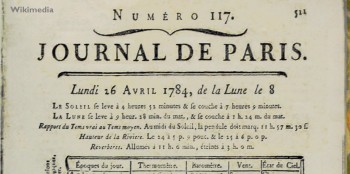Today, everybody’s a little bit Irish. And the people who are normally just a little bit Irish are wearing Notre Dame shirts and getting into fistfights. It’s St. Patty’s Day, and the bars are enticing us all with green beer and playing Flogging Molly and Riverdance on the speakers. But who was St. Patrick, and why do we celebrate his day by getting sloshed?
Next to St. Nicholas, St. Patrick is probably the most widely known person with a St. in front of his (or her) name, though he was never formally canonized by any pope. Patrick, or Padraig in Irish, is based on the Latin word patricius, which simply means “father.” He was born Maewyn Succat in Scotland in the fourth century, though it’s hard to pinpoint anything more specifically. He was kidnapped by Irish pirates as a teenager (seriously), and brought to Ireland as a slave. At the supposed urging of God, he escaped captivity and ran 200 miles to a port with a ship bound for England.
Patrick joined the priesthood and then went right back to Ireland to become bishop of Armagh. He was famed for using the Irish weed, the shamrock, to explain the concept of the Christian trinity: one God with three distinct entities. Such a teaching would have resonated with pagan Irish, who already revered the shamrock and had a few models of three-in-one deities, such as the Morrígna of Macha, Anann, and The Morrígan. After many years trying to convert the Irish amid hostile conditions, Patrick, friendless and generally disliked, died March 17, supposedly, of an unknown year.
His legacy, however, did not. Early writings after Patrick’s time referred to him as a warrior priest who carved out converts from the pagan druids (though there is no real evidence of this) and established the highest moral virtues in great lords and ladies. Many accounts blur the line between Patrick and one or two other church representatives in Ireland at or near the same time. Regardless, Ireland became a Catholic country through and through, and Patrick was given the credit.
Stories about Patrick include how he prayed all the snakes away (though evidence would indicate there were never any snakes in Ireland in the first place) and that he once took so long giving a sermon that a staff he planted in the ground at the beginning grew into a tree by the end. He is a revered figure throughout Ireland, swept up in the cultural and religious identity of the island, and his feast day, the purported day of his death, is celebrated by breaking the Lenten fast and indulging in a little booze. So remember that you’re in mourning when you’re chugging green (or otherwise) beer tonight.
Now let’s talk a little bit about that booze. If you’re drinking beer (Old English beor, probably borrowed from Latin biber, “to drink”; or derived from Proto-Germanic beuwo, “barley”), go for Guinness in Ireland’s honor. Our “Modern Urban Gentleman” has already given a nice primer about the drink, but allow me to expand a bit.
Beer is made from malted grains (malting is the process of soaking grains in water and then heating them up rapidly, to turn the starch into soluble sugars) left to ferment (yeast eats at the sugar and poops alcohol). Most all beer today contains hops, for the bitter flavoring and as a preservative. Initially, the term “ale” (Proto-Indo European alu, “sorcery, possession, intoxication”) was used to mean “beer without hops,” but by the 18th century, they all used hops, and the term “ale” came to mean “beer brewed in the country” as opposed to in town. (Today, “ale” is specific to beer produced through top-fermenting yeast, versus bottom-fermented “lager.”)
Beer is one of the building blocks of civilization, indirectly responsible for every technological advancement from farming to refrigeration. The drink’s economic value throughout history cannot be overstated. Need something made cheaply that can serve as food, medicine, and suppression of rebellious inclinations for the masses? Look no further!
The first beer was probably brewed sometime around 9500 B.C, along with the introduction of cereal (Latin cerealis, “of Ceres,” the Roman goddess of harvest and agriculture). One of the earliest recipes for beer comes from the Sumerian religion, where Ninkasi, the goddess of beer, had her own hymn which essentially laid out how to make the stuff in an easy to remember, spoken litany. Beer came to Ireland around 3000 B.C., and might well have been brewed with a little bit of opiate in the mix, against pharmaceutical advice.
What’s the other Irish drink? Oh, right. Whiskey! Everyone but the Americans and the Irish spell it “whisky” (Gaelic uisce beatha, “water of life,” as Latin aqua vitae). Jameson and Bushmills are the go-to choices, while the Modern Urban Gentleman recommends Redbreast. Distilled spirits haven’t had nearly the storied history of beer (or wine). Distillation as a practice — that is: boiling out the different parts of a chemical solution, in this case to get all the alcohol into one container — may be only as old as about the 13th century, where it was done in Italy. Back then, these beverages were largely made in monasteries and used as medicinal anesthetic and antiseptic. Think rubbing alcohol. It didn’t take long to become recreation, however.
Beer and wine can only reach alcohol levels of about 20 percent, maximum, before the yeast starts to die off faster than it poops. Distilled liquor (from Latin liquere, “to be liquid”), made of barley (whiskey), potatoes (vodka), sugarcane (rum), wine (brandy), and other produce, can get much more alcoholic than that.
A brief side note about the nomenclature for alcohol levels, because it’s interesting: We typically use ABV — alcohol by volume — these days, because it’s useful and easy. However, you may have heard the term “proof” to refer to this as well. The term comes from 18th-century British naval convention, when sailors might have been paid in rum. In order to determine that the bottles were alcoholic “enough,” some of the liquor was set afire. If it burned, meaning it was at least 57 percent (four-sevenths) alcoholic, it was “proved.” Therefore, 100 proof meant four parts alcohol per seven. Since then, the term has gone out of fashion everywhere except the United States, where we use it, largely for style purposes, to mean twice the alcohol percentage (i.e. 80 proof means 40 percent ABV).
So, no matter what you’re drinking tonight, remember to be safe, raise a glass to the departed, and keep away from snakes!









